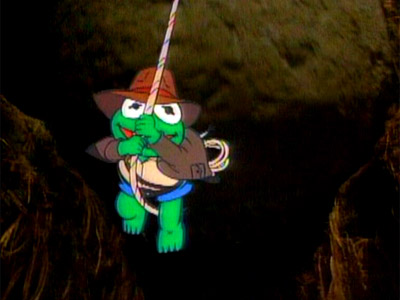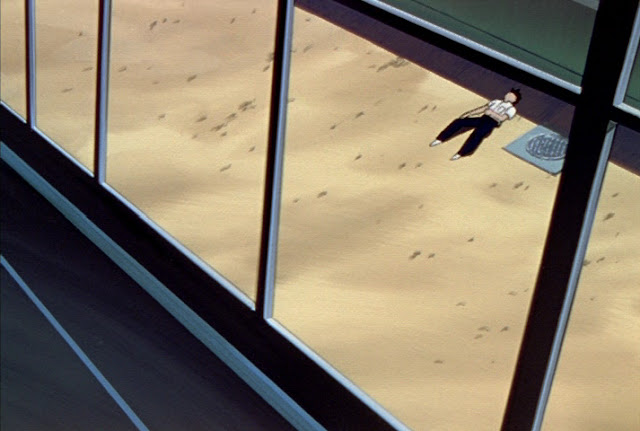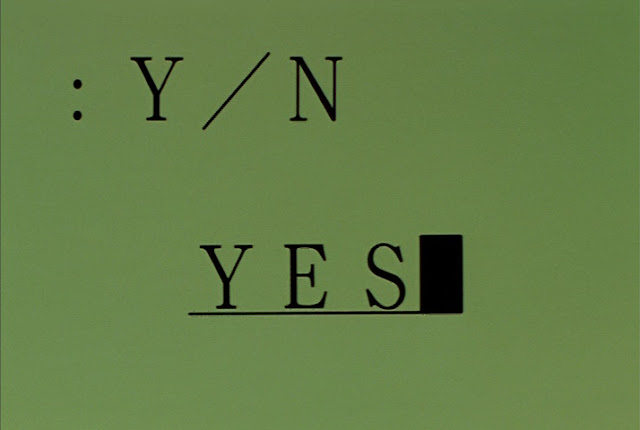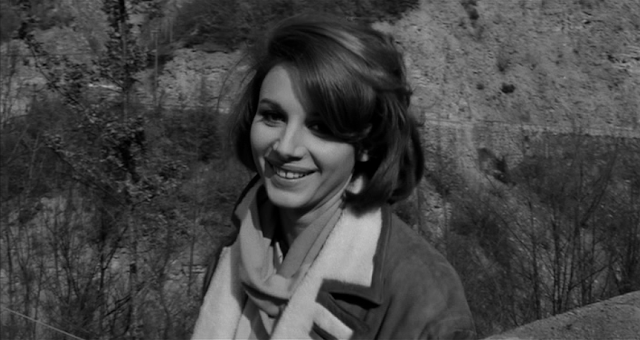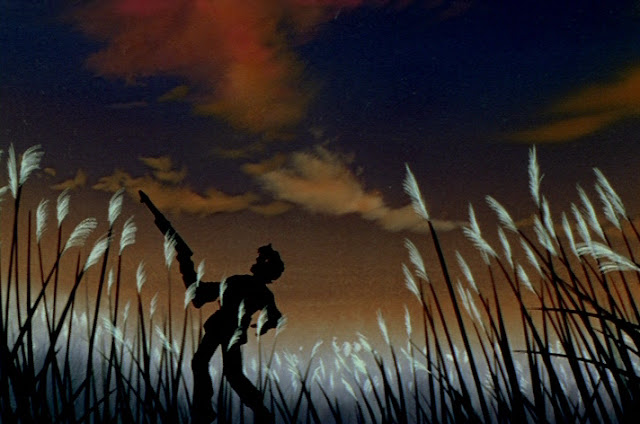Which is the bigger movie news? That a
Star Wars: Episode VII is in the works? Or that the Disney corporation will be making it, having bought out Lucasfilm on Tuesday? Let's begin with that first story. What will
Episode VII cover? Conceived as Anakin Skywalker's rise, fall from grace, and eventual redemption, where could the
Star Wars narrative possibly go once the fallen Jedi's corpse goes up in flames on the forest moon on Endor? I've long though that the most compelling angle would be to show the Rebel Alliance, having finally and impossibly brought down the Evil Empire, becoming something of an Empire itself. Perhaps a
new resistance could emerge, radical, indignant, making the former Rebels question who they have really become. Certainly such a storyline would have historical precedent - how many revolutions have turned into regimes resisting the next revolution? But it would also neatly reflect the
Star Wars saga itself, by which I mean not the movies onscreen but the grand ascension of a unique, original myth into industry gamechanger, pop cultural icon...and big, billion-dollar business.
For years, nay decades, critics, cultural commentators, and disgruntled fanboys have called George Lucas a sellout. He and Steven Spielberg, often associated as a kind of Tweedle Dee and Tweedle Dum of blockbuster cinema, were blamed for polluting the purity of New Hollywood, for opening the doors to the barbarians - dumbing down content, obsessively refocusing the criterion of success on opening weekend, and creating an environment in which big budgets were necessary to be considered important. Spielberg is usually seen as an ambivalent mixture of auteur and mogul, one foot in the make-a-buck mentality the other in express-your-vision integrity - and because of this, he's more likely to be defended by those who see him as an artist first and foremost, whatever top hat he dons in the corporate boardoom. Lucas, on the other hand, who left the director's chair after the first
Star Wars and only returned for three
Star Wars spinoffs, is usually seen as a businessman full-stop, without the filmmaking chops to justify any apologia.
Yet in a way, George Lucas' transformation from auteur into mogul is even more ironic than Spielberg's. After all, Spielberg was an industry stalwart from the beginning, smuggling himself onto the Universal lot and impressing studio heads with his unapologetic chutzpah and brainy inquisitions. Aside from an independently-produced short film which, six years before his first feature, helped him get in the door as a TV director, Spielberg received opportunities from within rather than boring his way from without (distinguishing him from all the 60s and 70s stalwarts who ground their teeth on underground movies or Roger Corman-produced exploitation flicks). What's more, unlike virtually all of his New Hollywood peers, Spielberg never attended film school (his grades weren't good enough) and thus didn't have the formal grounding in film-as-art that most other directors of his generation took for granted.
Lucas, on the other hand, first wormed his way into the industry as part of a gang of outsider outlaws, a protegee of Francis Ford Coppola and his American Zoetrope, committed to unsettling, subversive visions of society very much grounded in the countercultural milieu of the time. Lucas'
THX 1138, still his most stylistically impressive film (the one that proves he wasn't just an abstract visionary, but a concretely talented filmmaker), offers a dystopian view of the future - and of the present; it, or at least the student film it was drawn from, was shot like
Alphaville, in ultra-modernist settings that needed little alteration to suggest a cold, metallic society on the horizon. Lucas' conception for
Apocalypse Now, eventually transformed over by Coppola into an operatic epic, was similarly guerrilla-style: he hoped to shoot it in pseudo-documentary, partially in Vietnam itself.
There's a story I read a few years ago, when Robert Downey Jr.'s personal comeback was being pimped to sell
Iron Man, about the actor tossing his last stash of drugs in the trash, heading over to Burger King (I think it was Burger King) and chowing down on a Whopper to signify his newfound lease on life. In the same article, Downey bemoans starring in films no one went to see and brashly embraces the notion of being tied to a major franchise. Selling out and spiritual redemption are unapologetically interchangeable in this formulation, which presumably owes less to Downey's undoubtedly earned sense of relief than to the publicity machine's canny sense of maneuver. Cynics might be tempted to see Lucas' creation of
The Star Wars in the mid-70s in the same light, as a let's-give-'em-what-they-want sop to the mainstream, coming from a filmmaker tired of being marginalized (Zoetrope was in dire straits,
THX was a flop) and enticed by his first taste of audience-pleasing success with
Graffiti.
In fact, as even the cynics must know,
Star Wars was a difficult sell and a miserable shoot. It was a passion project if ever there was one, and the scrappy kid in his early thirties, shopping his bizarre mashup of totally divergent genres and sensibilities around Hollywood, was barely able to get it off the ground. Despite the familiarity of what followed, it was far from guaranteed at the time - and to this day
Star Wars excites not just the senses by the more conscious side of imagination in a way few other blockbusters could possibly hope, partly because the nerve of what Lucas was doing can't help but be manifested in onscreen energy and invention.
Star Wars is
sui generis, the perfect crossroads between crowd-pleasing touchstone and personal idiosyncrasy, the kind of astrological alignment that can only happen once. In a sense, all blockbusters since - all summer spectacles and popcorn flicks - have been essentially redundant.
Star Wars did it first and best, and there was no reason to follow in its footsteps really, except - of course - to make a buck.
And make a buck both Lucas and his imitators certainly did. What happened after
Star Wars became an unexpected phenomenon has been covered, ad nauseum elsewhere; but it didn't just change the industry or the special-effects film, it changed Lucas, who became trapped in the universe he had created. From then on, it was virtually all
Star Wars, all the time. The playfulness of the first film risked getting drowned out not only by the cacophony of the merchandising deluge but also the officially, self-consciously mythologizing approach taken in the ensuing movies. Both aspects institutionalized
Star Wars, a movie whose delight was its very lightness, the way it captured the spirit of kids' play with high-tech sophistication, losing nothing of that innocent spirit in the maturity of its craftsmanship.
At times, Lucas himself seemed ambivalent about the Pandora's box he'd opened - not least in terms of its effect on his own career. Meanwhile, Lucas' plaintive musings about those "experimental art films" he always hoped to return to became ritualistic gestures repeated in countless interviews, like Downey's burger epiphany in reverse, only never fulfilled; probably, among other reasons, because the cocoon of his familiar success was too comforting. Lucas hated directing, it caused him nothing but anxiety, and his greatest film arose of this sense of personal risk and fear of failure. Our greatest achievements are seldom the most enjoyable experiences, and it's little wonder that Lucas, by all accounts a pessimistic, nervous, withdrawn individual, sought to avoid such misery in middle age by building upon the foundation he'd so exhaustingly established instead of starting something new.
Well, maybe now he'll have the chance to experiment again - though he'll serve as "creative consultant" on the new
Star Wars films, there's no doubt his role will essentially be hands-off, his presence more of a marketing strategy than any genuine artistic control. He himself has phrased the sale in such terms, saying, ""It's now time for me to pass `Star Wars' on to a new generation of filmmakers."
"Filmmakers." I do not think "filmmakers" will have the lead in crafting the new trilogy, which has already been slotted for a 2015 release, taking its place as a locked-in-stone studio product like all the other franchises and reboots rolling off the Hollywood assembly line. It will be primarily a work of advertising gurus, studio executives, hype men, and the publicity machine. They will dictate the content, finally and completely fulfilling the foreboding many fans felt when confronted by the cute and cuddly Ewoks in
Return of the Jedi - the suspicion that storytelling was taking a backseat to merchandising. This will no longer be a suspicion, but a simple fact. As I began by saying, Lucas has been accused of selling out for years. Now that it's literally true in a matter-of-fact, make-of-it-what-you-will sense, it only makes me realize how idiosyncratic and almost kind of quixotic his presence in Hollywood was for those three decades since Lucasfilm's formation.
His was an empire spun from personal dreams and individual vision rather than a kind of committee approach to giving the public "what it wants." No one who harbors any last shred of the auteurist world-creating dream, in which the bohemian impulse toward self-expression and the archetypally American entrepreneurial spirit subtly intertwine, can fail to be impressed by the degree to which Lucas owned his own creation. There's something both inspiringly human and thrillingly mythic in the notion that an individual can fashion an entire universe - that from one seed a mighty oak can spring. How rich that universe could seem, with its characters and themes, its spin-off and mass media references, its multiplicity despite the individual source. How much is such a universe worth? Well, now we know: $4.4 billion.
And I feel like F. Scott Fitzgerald, ascending the Empire State Building and crushed to find out that his New York of the mind had physical limits, was surrounded - threatened - by the impersonal landscape around it (certainly such thoughts of an ominious natural force encroaching on Manhattan seem even more sadly evocative this week). "Full of vaunting pride," Fitzgerald wrote, "the New Yorker had climbed here and seen with dismay what he had never suspected, that the city was not the endless succession of canyons that he had supposed but that it had limits - from the tallest structure he saw for the first time that it faded out into the country on all sides, into an expanse of green and blue that alone was limitless. And with the awful realization that New York was a city after all and not a universe, the whole shining edifice that he had reared in his imagination came crashing to the ground."
Even my criticisms of Lucas's artistic and commercial decisions of the past fifteen years were tied to his individuality - at least these were decisions
he had made. The prequels still don't really work for me but they are, when all is said and done, the work of an individual, of a singular human being and his collaborators. The hive mentality of the Disney corporation has no room for such things and whatever else the
Star Wars of 2015 will be, we can be assured it will be slick, safe, and slightly inhuman. In this the sequels will very much fit our 21st century blockbuster template, its original source long forgotten, not in name (the price that name commands is still evidence of that) but in spirit. The supposed heirs to its legacy have forgotten
Star Wars' imaginative emphasis on texture and detail, its respect and enthusiasm for everything from ancient myths to early Hollywood history, its mixture of childlike sincerity and a boyish inability to take itself
too seriously (by contrast today's franchises, even the better ones, alternate between glib adolescent solemnity and hey-we're-all-in-on-the-joke-here cynicism).
The saddest comment of all, the point that this deal somehow drives home for me, is that if a 33-year-old George Lucas were to try sell his quirky space adventure to a studio today, he'd be laughed off the lot. Not only would the industry interfere with his vision every step of the way, not only would it make sure to place the highest authority in marketing hands, it wouldn't even approve the project in the first place. No built-in audience? No name franchise recognition? An original universe - fresh characters - an unusual approach? Forget about it. Disney wouldn't buy a 2012
Star Wars for 4 dollars and 4 cents.
Never mind that there'd be no Lucasfilm without those disdained qualities - nor, for that matter, would there be any Disney.
Indeed, Hollywood itself - created by nervy immigrants fleeing a corporate trust back east - has always thrived on the energy of outsiders and innovators, only to see them either ruthlessly cast aside, swallowed up, or driven to form the very entities they initially resisted. And the process repeats itself, on and on - turtles all the way down.
So congratulations to Lucas and best wishes for a future that no longer circulates around that expressive liberation which eventually became a creative imprisonment. Good luck to the unlucky writers and directors newly shackled to
Star Wars; if you thought the prequels came under fire, just wait until its your turn. As for myself, sure, I look forward to the next
Star Wars with mild curiosity but it will be the next
Star Wars in name only.
I suspect we'll have to look elsewhere for the
real "next
Star Wars." We can be pretty sure it won't be coming from Hollywood.

